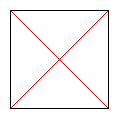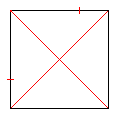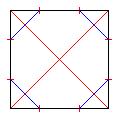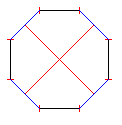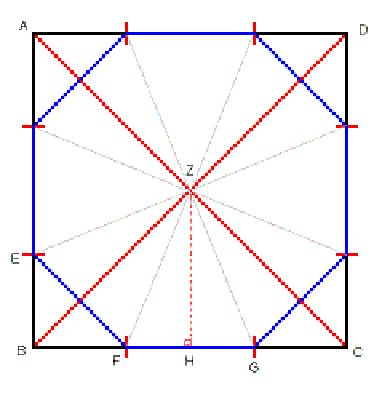In World War II, my father was a Chief Carpenter's Mate in the Sea Bees (Construction Batallion) on Saipan.
One day, his crew was assigned to lay out the forms for an octagonal concrete pad for a water tower.
The LT, bright young civil engineer that he was, told my father to wait for him to return with the angles and measurements for the form and to not have the crew do anything.
Then he left for his office to use his book of trig tables and his slide rule.
As soon as he left, my father laid out the pad and put the men to work.
When the LT returned, he was furious, but then as he measured the form he was amazed to find that my father had laid it out perfectly.
"How did you do that, Chief?" "Oh, I dunno. Just threw it together. Lucky, I guess."
No, he wasn't just lucky. He knew exactly what he was doing.
At the beginning of the war, my father wanted to enlist, but he wasn't allowed to because he worked in the shipyard, a vital defense industry.
So in order to enlist, he had to quit his job at the shipyard.
While his enlistment was being processed, he still had to support his family, so he work a few jobs, including one in which he made traffic signs.
It was while making stop signs there that he learned how to construct a perfect octagon.
And it works for any size of octagon.
Without having to calculate any measurements.
Consider the diagram below in which square ABCD is used to construct an octagon:
From the definition of a regular polygon, we know:
- That a regular octagon will contain 8 identical isoceles triangles.
- That the internal angle of each triangle -- eg, the angle FZG -- will be one-eighth of a full circle; ie, 360° / 8 = 45°.
- That each face of the octagon will be of identical length; eg, the line segments EF and FG.
The approach of the proof will be to demonstrate that all three of these facts hold for the octagon constructed from the square ABCD.
To start with, let's calculate the lengths of the line segments:
- Assign the length, s, to the side of the square; eg, line segment AB.
Since this is a square, we know that all four sides have the same length, which is s.
- The length of the diagonals (AC and BD) are obtained from the Pythagorean Theorem:
s2 + s2 = AC2
AC = SQRT(2s2)
AC = s * SQRT(2)
- The compass is set to half the length of a diagonal, therefore to AC/2 or SQRT(2) * s/2 .
- The line segments created with the compass are of length SQRT(2)*s/2; eg, AE, BG, CF.
- The shorter line segments this creates about each corner (eg, BE, BF) are of length:
s - SQRT(2)*s/2
- The octagon faces that lie on the square (eg, FG) are of length:
FG = s - 2 * (s - SQRT(2)*s/2)
FG = s - 2s + SQRT(2)*s
FG = s * (1 - 2 + SQRT(2))
FG = s * (SQRT(2) - 1)
- Consider now the length of the octagon faces that lie across the square's corners and that are formed by cutting the corners off (eg, EF).
This could be determined by applying the Pythagorean Theorem, it turns out that we're dealing with
right isoceles triangles again (eg, the triangle BEF), as was the triangle ABC in item #2 above.
Thus we already know that the length of segment EF will be BE * SQRT(2). Therefore:
EF = BE * SQRT(2)
EF = (s - SQRT(2)*s/2) * SQRT(2) [from item #5]
EF = s*SQRT(2) - s
EF = s*SQRT(2) - s
EF = s * (SQRT(2) - 1)
EF = FG [from item #6]
Fact #3, "each face of the octagon will be of identical length; eg, the line segments EF and FG"
has been proven.
- To determine the internal angle, FZG, we divide it in half by dropping the perpendicular, ZH.
ZH has a length of s/2 and FH is half the length of FG, s/2 * (SQRT(2) - 1).
This forms a right triangle ZHF with an internal angle FZH and the trigonometric property:
tan(FZH) = FH / ZH
tan(FZH) = (s/2 * (SQRT(2) - 1)) / (s/2)
tan(FZH) = SQRT(2) - 1
tan(FZH) = 0.414213562373
FZH = arctan(0.414213562373)
FZH = 22.5°
FZG = 2 * FZH
FZG = 2 * 22.5°
FZG = 45°
Fact #2, "the internal angle of each triangle -- eg, the angle FZG -- will be one-eighth of a full circle; ie, 360° / 8 = 45°"
has been proven.
- By inspection, we see that the octagon is divided into eight isoceles triangles.
Each triangle has the same angles and the same length sides.
Therefore, they are 8 identical triangles.
Fact #1, "a regular octagon will contain 8 identical isoceles triangles"
has been proven.
All three facts have been proven.
Therefore, this puppy is a regular octagon.
QED

